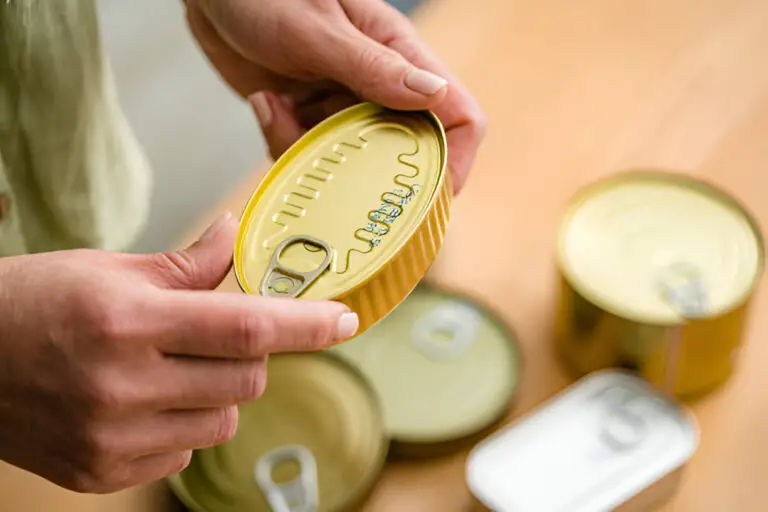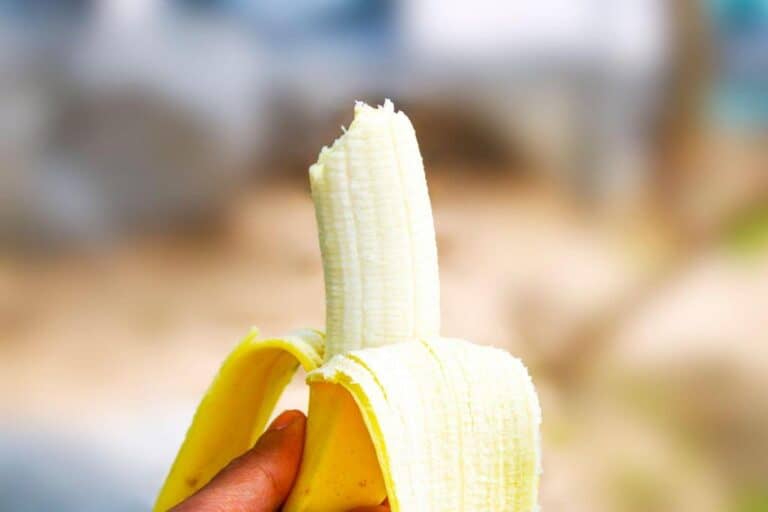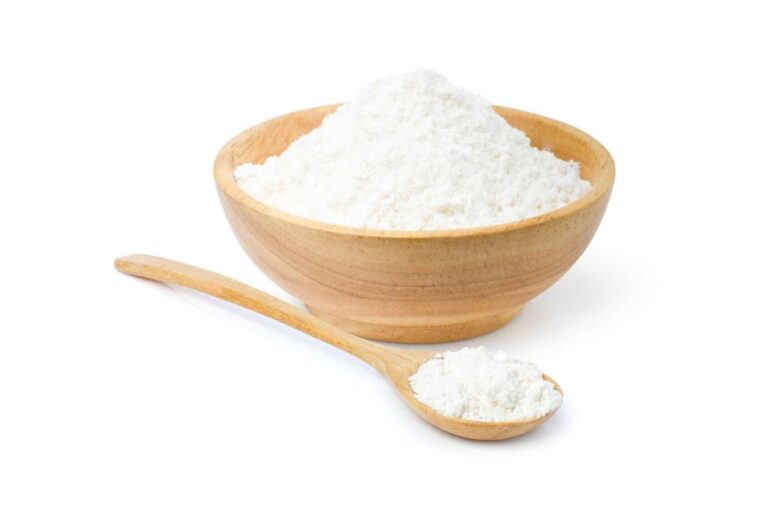Can You Eat Parmesan with Mold and White Spots on It?
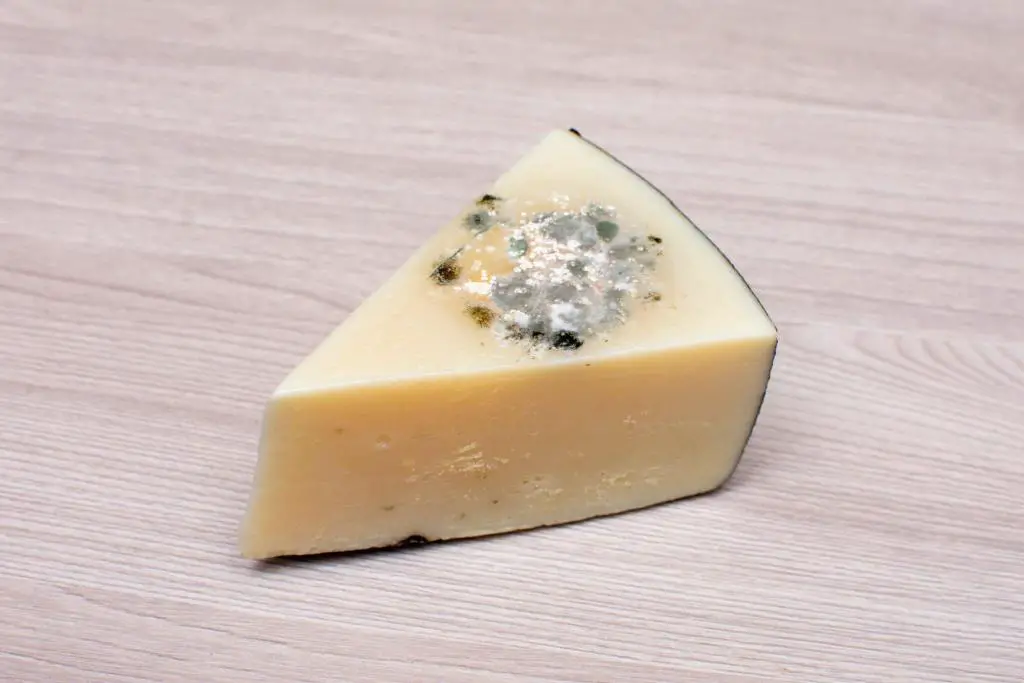
Parmesan cheese, with its rich and distinctive flavor, is a beloved staple in many households and culinary ventures. However, encountering mold or white spots on this delectable cheese can leave even the most experienced food enthusiasts puzzled.
So, is it safe to consume Parmesan with mold? Can cooking salvage the situation? How far does mold penetrate this aged cheese? In this article, we will explore these questions and more to help you navigate the world of Parmesan cheese and its potential mold-related predicaments.
Grated and Shredded Parmesan Cheese: What’s the Difference?
These two variations offer distinct characteristics that can elevate your meals in unique ways.
Grated Parmesan, as the name suggests, involves turning the cheese into fine, powdery particles. This texture is perfect for dusting over pasta, salads, and soups. It dissolves quickly, infusing your dishes with a burst of savory goodness.
On the other hand, shredded Parmesan is all about those thin strips or strands. It adds a delightful touch of crunch and can be used as a cheese topping for pizza, pasta, or even as a cheesy garnish on your favorite salads. It retains its shape, creating a contrasting texture alongside other ingredients.
Let’s break it down:
| Grated Parmesan | Shredded Parmesan | |
| Texture | Fine, powdery | Thin strips/strands |
| Ideal for | Dusting and quick dissolution | Topping, crunch |
Read: Can You Eat Shredded Cheese with Mold?
Understanding Mold on Parmesan Cheese
Before we discuss whether it’s safe to eat Parmesan with mold, you need to understand what mold is and how it develops on cheese. Mold is a type of fungus that can grow on various foods, including cheese. In the case of Parmesan, mold can appear as fuzzy white or greenish-blue spots. These molds can range from harmless to potentially harmful, depending on several factors:
Types of Mold on Parmesan
Mold on cheese can belong to one of three categories:
- Beneficial Mold: Some molds, like Penicillium candidum, are intentionally added to cheese during the production process. They are safe to eat and often enhance the flavor and texture of the cheese.
- Harmless Surface Mold: This category includes molds that grow on the surface of cheese but don’t penetrate deeply. These molds, often white or light in color, are typically safe to consume.
- Potentially Harmful Mold: Some molds, especially those with dark or off-putting colors, can penetrate the cheese and produce mycotoxins, which can be harmful if ingested.
To determine whether it’s safe to eat Parmesan with mold, you’ll need to identify the type of mold present on the cheese and consider the following factors:
- Appearance: Observe the color, texture, and size of the mold spots.
- Smell: Moldy Parmesan may emit an unpleasant odor if it’s gone bad.
- Texture: Check if the mold has penetrated deep into the cheese or is only on the surface.
Safety Considerations
Now, let’s address the burning question: Can you eat Parmesan with mold? The answer isn’t a straightforward “yes” or “no” because it depends on the type of mold and the cheese’s condition. Here are some key safety considerations:
- Beneficial Mold: If you spot white spots on your cheese, it could be beneficial mold intentionally introduced during the cheese-making process. These molds are safe to eat and can even enhance the cheese’s flavor. Simply scrape or cut off the affected area, and the rest of the cheese should be fine.
- Harmless Surface Mold: Most white mold spots fall into this category. As long as the mold is only on the surface and hasn’t penetrated deep into the cheese, you can safely consume Parmesan by removing the moldy parts.
- Potentially Harmful Mold: If you notice mold with dark or unusual colors, a foul odor, or a slimy texture, it’s best to discard the cheese. These signs may indicate the presence of harmful mold that has penetrated the cheese, producing mycotoxins that could make you sick.
To ensure your safety, use your senses and judgment when evaluating moldy Parmesan. When in doubt, remember the age-old adage: “When in doubt, throw it out.”
What Does Mouldy Parmesan Look Like?
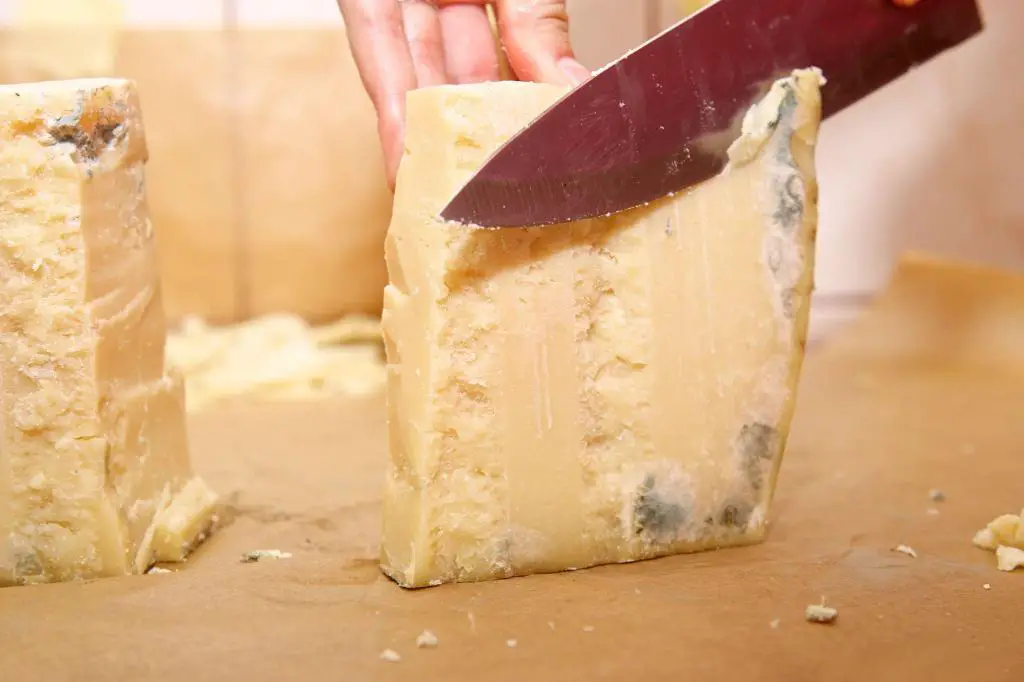
Mold and white spots on Parmesan can present in various forms, each signifying specific stages of the cheese’s aging process or potential contamination. Mold on Parmesan typically appears as fuzzy patches, blue-green spots, or discolored areas that deviate from the cheese’s characteristic pale yellow hue.
The texture of the mold can range from powdery to velvety, depending on the type of mold present. These unwelcome additions can alter the cheese’s appearance, texture, and aroma, indicating potential spoilage or unsafe conditions for consumption.
You need to distinguish between natural aging characteristics, such as white spots resulting from crystallization, and abnormal mold growth, which can compromise the cheese’s quality and safety.
The development of mold and white spots on Parmesan signifies the presence of microorganisms that thrive in specific environmental conditions, including temperature, humidity, and exposure to air. These conditions create an ideal breeding ground for mold spores, leading to the visible manifestation of white spots or fuzzy layers on the cheese’s surface.
The growth of mold can spread rapidly, infiltrating the cheese’s inner layers and potentially producing mycotoxins, which pose health risks if ingested. Understanding the visual cues of mold and white spots on Parmesan is crucial in determining the cheese’s edibility and ensuring a safe culinary experience for consumers.
While some white spots may signify natural crystallization, extensive mold growth can manifest as a velvety layer, indicating potential contamination. Differentiating between harmless natural processes and hazardous mold growth is essential in preserving the quality and safety of Parmesan.
Regularly inspecting the cheese for any signs of abnormal discoloration or texture can aid in identifying potential mold infestations and prompt necessary actions to prevent health hazards.
Is Eating Moldy Parmesan Cheese Okay?
The million-dollar question that lingers on every cheese connoisseur’s mind is whether consuming moldy Parmesan is a safe bet. In general, it’s advisable to steer clear of moldy cheese, including Parmesan, to prevent potential health complications.
While some types of mold are harmless, others can produce mycotoxins that may lead to adverse reactions, especially in individuals with compromised immune systems or allergies. Thus, the consumption of moldy Parmesan should be approached with caution, and discarding any cheese with visible mold is the best course of action to ensure one’s well-being.
Related: Eating Moldy Mozzarella Cheese: Is It Still Safe?
Can Cooking Kill the Mold in Parmesan?
The prospect of salvaging moldy Parmesan through cooking might seem like a plausible solution. However, the effectiveness of this method largely depends on the type of mold present and its penetration depth within the cheese.
Cooking, especially at high temperatures, can eliminate certain molds, making the cheese seemingly safe for consumption. Nevertheless, this method may not eradicate mycotoxins that could have developed during the mold’s growth, rendering the cheese unsafe despite the apparent elimination of visible mold.
Moreover, the texture and flavor of the Parmesan may be significantly altered after cooking, diminishing the cheese’s quality and taste. While cooking might be a temporary remedy, it’s imperative to exercise caution and prioritize one’s health when dealing with moldy Parmesan.
How Far Does Mold Grow in Parmesan?
Mold can permeate deep within the cheese, often extending beyond the surface and infiltrating the inner layers. The crumbly texture of Parmesan makes it particularly susceptible to mold penetration, as the cheese’s structure allows for air circulation, providing favorable conditions for mold growth.
Despite its hard texture, the presence of moisture within the cheese, coupled with inadequate storage conditions, can facilitate the rapid spread of mold. Therefore, inspecting the entire block of Parmesan for any signs of mold, even beyond the visible areas, is crucial in determining its edibility.
What Is The Shelf Life of Parmesan?
Proper storage and handling can significantly extend the cheese’s longevity, allowing you to savor its distinct taste over an extended period. Typically, Parmesan can last for several months, and in some cases, even up to a year when stored under optimal conditions.
The shelf life of Parmesan largely depends on factors such as the cheese’s initial quality, storage environment, and packaging. When stored in a cool, dry place, preferably in the refrigerator, and in an airtight container, Parmesan can maintain its freshness and flavor for an extended period of time. However, it’s important to note that the cheese’s shelf life may vary, and regular inspection is crucial to identify any signs of spoilage or mold growth.
How Can I Stop Parmesan From Getting Moldy?
Preventing mold growth on Parmesan involves implementing effective storage practices and maintaining optimal environmental conditions. By adhering to the following preventive measures, you can inhibit mold development and preserve the cheese’s quality:
- Proper Storage: Store Parmesan in the refrigerator, ideally in the cheese drawer or in an airtight container to minimize exposure to moisture and air, which can accelerate mold formation.
- Airtight Packaging: Utilize vacuum-sealed bags or tightly sealed containers to prevent air circulation and moisture absorption, creating an unfavorable environment for mold spores.
- Regular Inspection: Routinely examine the cheese for any signs of mold or unusual discoloration, especially in hard-to-reach areas, to address potential issues promptly and prevent mold proliferation.
- Hygienic Handling: Maintain good hygiene practices when handling Parmesan, ensuring that utensils and hands are clean to avoid cross-contamination and mold transfer.
By incorporating these preventive measures into your Parmesan storage routine, you can prolong the cheese’s shelf life and maintain its exquisite flavor and texture.
Does Unrefrigerated Parmesan Go Bad?
The decision to leave Parmesan unrefrigerated can impact its shelf life and overall quality. While Parmesan can withstand room temperature for a limited period, prolonged exposure to heat and humidity can hasten spoilage and mold growth, significantly diminishing its shelf life.
Unrefrigerated Parmesan is susceptible to moisture absorption and increased exposure to air, creating favorable conditions for mold spores to thrive. Consequently, the cheese’s texture may become grainy, and its flavor can deteriorate rapidly when left at room temperature for extended durations.
To ensure the longevity and freshness of Parmesan, it is advisable to store it in the refrigerator or a cool, dry place to inhibit mold growth and preserve its superior taste and texture.
How Do I Know If My Parmesan Cheese Has Gone Bad?
Detecting signs of spoilage in Parmesan is vital in preventing the consumption of deteriorated cheese, which can lead to potential health risks. While the aging process may alter the cheese’s texture and flavor, certain indicators signify that the Parmesan has gone bad. Look out for the following signs of spoilage:
- Mold Growth: The presence of visible mold, especially fuzzy or discolored patches, indicates that the cheese has surpassed its prime and is no longer safe for consumption.
- Unpleasant Odor: A pungent or sour smell emanating from the cheese signifies the development of harmful bacteria, rendering the Parmesan unfit for consumption.
- Unusual Texture: A grainy or excessively dry texture, accompanied by a lack of the cheese’s characteristic smoothness. The Parmesan has deteriorated and should be discarded.
- Off-putting Taste: A bitter or rancid taste in the Parmesan cheese is a clear indication of spoilage, highlighting the presence of harmful compounds that can compromise one’s health.
Regularly inspecting the cheese for these telltale signs of spoilage can aid in determining its edibility and ensuring a safe culinary experience.
FAQs on Is It Safe to Consume Moldy Parmesan?
Can you eat Parmesan cheese with white spots?
White spots on Parmesan often indicate crystallization, a natural part of the aging process. These spots are safe to consume and do not pose any health risks.
Is it safe to eat moldy Parmesan after cutting off the moldy part?
Cutting off the moldy part of Parmesan does not guarantee safety. Mold can penetrate deep into the cheese, and mycotoxins may have spread beyond the visible area, making the cheese unsafe to consume.
Can you freeze moldy Parmesan to kill the mold?
Freezing moldy Parmesan might temporarily halt mold growth, but it does not eliminate mycotoxins. Additionally, the texture and flavor of the cheese may be significantly altered after freezing and thawing.
Does grated Parmesan cheese with mold need to be discarded immediately?
Any Parmesan with visible mold should be discarded immediately. Consuming moldy grated Parmesan can pose serious health risks, as grating increases the surface area prone to mold contamination.
Can you use moldy Parmesan in cooking if you cook it thoroughly?
While cooking might kill some mold, it cannot neutralize mycotoxins, making the cheese unsafe for consumption. It’s best to avoid using moldy Parmesan in cooking to prioritize food safety.
What are the risks of eating moldy Parmesan for individuals with allergies?
Individuals with allergies may experience severe allergic reactions if they consume moldy Parmesan. It is advisable for individuals with allergies to avoid eating any mold-contaminated cheese.
Can moldy Parmesan cause food poisoning?
Moldy Parmesan can cause food poisoning if it contains harmful mycotoxins. Symptoms may include nausea, vomiting, abdominal pain, and, in severe cases, more serious health complications.

